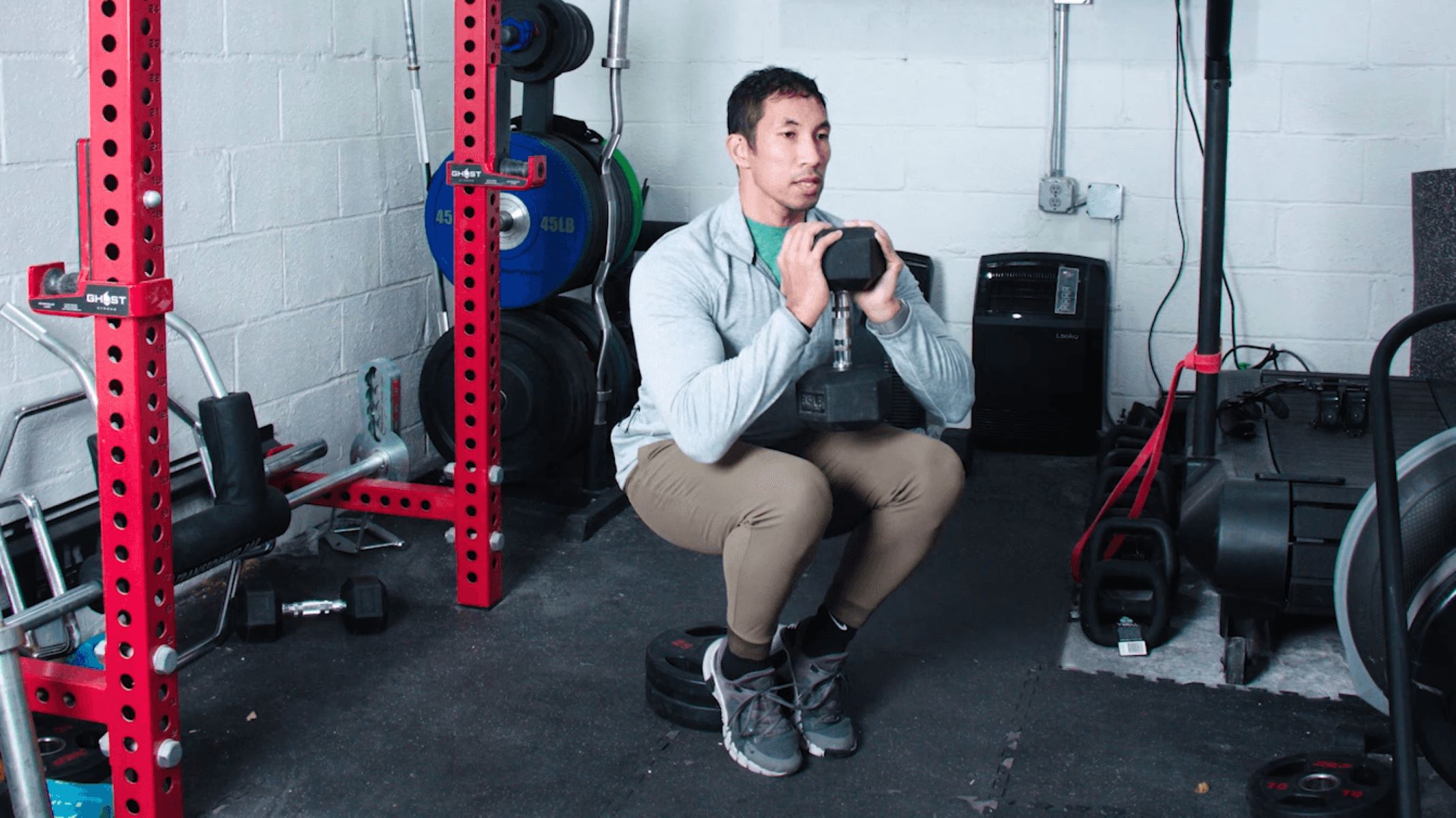Home>Health and Wellness>Heel Elevated Squats: The Surprising Truth About Their Difficulty Level!


Health and Wellness
Heel Elevated Squats: The Surprising Truth About Their Difficulty Level!
Published: January 28, 2024
Discover the surprising difficulty level of heel elevated squats and their impact on health and wellness. Uncover the truth about this effective exercise!
(Many of the links in this article redirect to a specific reviewed product. Your purchase of these products through affiliate links helps to generate commission for Regretless.com, at no extra cost. Learn more)
Table of Contents
Introduction
Heel elevated squats have gained popularity in the realm of fitness and strength training, and for good reason. This exercise, which involves performing squats with the heels elevated on a stable surface, offers a unique and effective way to target the lower body muscles while also challenging balance and stability. Whether you're a fitness enthusiast looking to diversify your workout routine or an athlete aiming to enhance performance, heel elevated squats may hold the key to unlocking new levels of strength and agility.
In this comprehensive guide, we will delve into the intriguing world of heel elevated squats, exploring their mechanics, benefits, common mistakes, and tips for mastering this exercise. By the end of this journey, you will gain a deeper understanding of the surprising truth about the difficulty level of heel elevated squats and how to conquer them with confidence.
So, strap in and get ready to discover the transformative potential of heel elevated squats as we embark on an enlightening exploration of this dynamic exercise.
Understanding Heel Elevated Squats
Heel elevated squats, also known as elevated heel squats, are a variation of the traditional squat exercise. This dynamic movement involves positioning the heels on a raised surface, such as weight plates, a wedge platform, or specialized squat shoes, while performing the squatting motion. By elevating the heels, this exercise alters the biomechanics of the squat, placing a greater emphasis on specific muscle groups and enhancing the overall challenge of the movement.
The primary purpose of elevating the heels during squats is to increase the range of motion at the ankle joint. This adjustment allows individuals with limited ankle mobility to perform squats with improved form and depth. Furthermore, heel elevation can help to mitigate the tendency for the knees to excessively travel forward during the squat, promoting a more upright torso position and reducing stress on the knee joints.
From a biomechanical perspective, heel elevated squats shift the emphasis towards the quadriceps, the group of muscles located at the front of the thighs. By altering the angle of the ankles and effectively reducing the demand on the calves, this exercise variation places a greater load on the quadriceps, leading to enhanced muscle activation and development in this key muscle group.
In addition to targeting the quadriceps, heel elevated squats engage the glutes and hamstrings to a significant degree. The altered positioning of the feet and ankles during this exercise requires greater involvement of the posterior chain muscles, contributing to a more comprehensive lower body workout.
It's important to note that while heel elevated squats offer unique benefits, they may not be suitable for everyone. Individuals with pre-existing ankle or foot conditions should exercise caution when performing this variation of squats and seek guidance from a qualified fitness professional to ensure safe and effective execution.
In essence, understanding heel elevated squats involves recognizing their ability to modify squat mechanics, enhance ankle mobility, and target specific lower body muscles. By grasping the intricacies of this exercise, individuals can harness its potential to optimize their training and achieve greater strength and functionality in the lower body.
Benefits of Heel Elevated Squats
Heel elevated squats offer a myriad of benefits that extend beyond traditional squat variations. By incorporating this dynamic exercise into your training regimen, you can unlock a range of advantages that contribute to overall strength, mobility, and athletic performance.
1. Enhanced Quadriceps Activation
Elevating the heels during squats places a greater emphasis on the quadriceps, the muscles at the front of the thighs. This heightened activation of the quadriceps leads to improved muscle development and strength in this crucial lower body muscle group.
2. Improved Ankle Mobility
One of the primary benefits of heel elevated squats is the enhancement of ankle mobility. By altering the angle of the ankles during the exercise, individuals with limited ankle mobility can perform squats with greater ease and depth, ultimately contributing to improved overall mobility and movement proficiency.
3. Increased Glute and Hamstring Engagement
While heel elevated squats target the quadriceps, they also engage the glutes and hamstrings to a significant degree. This comprehensive activation of the posterior chain muscles contributes to balanced lower body development and supports functional movement patterns.
4. Balance and Stability Challenge
Performing squats with the heels elevated requires heightened balance and stability, as the altered foot positioning necessitates greater control throughout the movement. This challenge not only strengthens the lower body but also enhances overall stability and proprioception.
5. Injury Prevention and Rehabilitation
For individuals with ankle mobility limitations or knee issues, heel elevated squats can serve as a valuable tool for injury prevention and rehabilitation. By reducing the stress on the knee joints and promoting a more upright torso position, this exercise variation can aid in mitigating potential injury risks and supporting the recovery process.
6. Diversification of Training
Incorporating heel elevated squats into your workout routine adds variety and diversity to your training regimen. This variation not only targets specific muscle groups but also introduces a new dimension to traditional squat exercises, keeping your workouts fresh and engaging.
7. Functional Transfer to Athletic Performance
The benefits of heel elevated squats extend beyond the gym, with the enhanced lower body strength, mobility, and stability directly translating to improved athletic performance. Whether you're a runner, a basketball player, or a weekend warrior, the gains from this exercise can positively impact your overall athletic abilities.
In summary, the benefits of heel elevated squats encompass improved muscle activation, enhanced mobility, balanced lower body development, injury prevention, and functional transfer to athletic endeavors. By embracing this exercise variation, individuals can unlock a wealth of advantages that contribute to their fitness journey and overall well-being.
Common Mistakes in Heel Elevated Squats
Mastering heel elevated squats requires attention to detail and a keen understanding of proper form and technique. However, individuals often fall prey to common mistakes that can compromise the effectiveness of this exercise and increase the risk of injury. By recognizing and addressing these pitfalls, you can optimize your performance and reap the full benefits of heel elevated squats.
1. Incorrect Heel Elevation
One of the most prevalent mistakes in heel elevated squats is improper heel elevation. Using an unstable or excessively high surface to elevate the heels can lead to instability and compromise balance during the exercise. It's essential to choose a stable and appropriate elevation, such as weight plates or a dedicated wedge platform, to ensure a secure footing and effective execution.
2. Forward Knee Travel
During heel elevated squats, allowing the knees to excessively travel forward beyond the toes can place undue stress on the knee joints and compromise proper biomechanics. Maintaining a controlled descent and ensuring that the knees track in line with the toes is crucial for preventing injury and maximizing muscle engagement.
3. Inadequate Core Engagement
Neglecting to engage the core muscles during heel elevated squats can lead to a loss of stability and compromised spinal alignment. Failing to brace the core and maintain a strong, upright torso throughout the movement can diminish the effectiveness of the exercise and increase the risk of lower back strain.
4. Lack of Ankle Stability
Insufficient ankle stability during heel elevated squats can impede proper form and detract from the targeted muscle engagement. Individuals with limited ankle mobility should focus on strengthening and stabilizing the ankle joints to ensure a solid foundation for performing this exercise effectively.
5. Overarching of the Lower Back
Allowing the lower back to arch excessively during heel elevated squats can lead to undue stress on the lumbar spine and compromise the integrity of the movement. Maintaining a neutral spine position and avoiding hyperextension of the lower back is essential for safeguarding against potential back injuries.
6. Rapid or Uncontrolled Descent
Descending too quickly or without control during heel elevated squats can diminish the effectiveness of the exercise and increase the risk of injury. A controlled and deliberate descent, focusing on maintaining proper alignment and muscle engagement, is essential for maximizing the benefits of this movement.
By being mindful of these common mistakes and prioritizing proper form and technique, you can elevate your performance and minimize the risk of injury during heel elevated squats. Taking the time to address these pitfalls will not only enhance the effectiveness of the exercise but also contribute to a safer and more rewarding workout experience.
The Difficulty Level of Heel Elevated Squats
The difficulty level of heel elevated squats is a topic that often elicits curiosity and intrigue among fitness enthusiasts and athletes alike. This exercise variation introduces a unique set of challenges that distinguish it from traditional squats, prompting individuals to question its level of difficulty and the factors that contribute to its demanding nature.
At first glance, heel elevated squats may appear deceptively similar to conventional squats. However, the subtle alteration of elevating the heels introduces a significant shift in biomechanics and muscle engagement, ultimately impacting the perceived difficulty of the exercise. By raising the heels on a stable surface, individuals effectively modify the angle of the ankles, leading to increased demand on specific lower body muscles and requiring heightened balance and stability throughout the movement.
The primary factor that contributes to the elevated difficulty of this exercise variation lies in the intensified emphasis on the quadriceps. Elevating the heels during squats effectively reduces the contribution of the calves, transferring a greater load to the quadriceps and demanding enhanced muscle activation in this key lower body muscle group. As a result, individuals often experience heightened fatigue and a more pronounced burn in the quadriceps during heel elevated squats, elevating the perceived difficulty of the exercise.
Furthermore, the alteration in ankle positioning necessitates improved ankle mobility and stability, adding another layer of complexity to the exercise. Individuals with limited ankle mobility may find heel elevated squats particularly challenging, as they must work to maintain proper form and alignment while navigating the increased range of motion at the ankle joint. This demand for improved ankle mobility and stability further contributes to the elevated difficulty level of this exercise variation.
In addition to the physical demands, the need for heightened balance and stability during heel elevated squats presents a notable challenge for individuals. The altered foot positioning requires individuals to engage their core muscles and maintain a strong, upright posture throughout the movement, adding a dynamic element of stability to the exercise. This heightened demand for balance and stability not only increases the overall difficulty of the exercise but also cultivates greater proprioception and body awareness.
It's important to recognize that the difficulty level of heel elevated squats is not a deterrent but rather a compelling aspect that underscores the transformative potential of this exercise. Embracing the challenges presented by this variation can lead to enhanced lower body strength, improved muscle activation, and heightened functional capabilities, ultimately contributing to a well-rounded and effective training regimen.
In essence, the difficulty level of heel elevated squats is a multifaceted aspect that encompasses increased quadriceps engagement, heightened demand for ankle mobility and stability, and the dynamic challenge of balance and stability. By acknowledging and embracing these challenges, individuals can harness the full benefits of this exercise variation and elevate their lower body training to new heights.
Tips for Mastering Heel Elevated Squats
Mastering heel elevated squats requires a combination of focused technique, mindful execution, and strategic adjustments. By incorporating the following tips into your training approach, you can enhance your proficiency in this challenging exercise and reap the full benefits it has to offer.
-
Gradual Progression: Begin by gradually introducing heel elevated squats into your workout routine. Start with a modest elevation height and focus on mastering the movement pattern before progressing to higher elevations. This gradual approach allows your body to adapt to the altered mechanics and minimizes the risk of overexertion.
-
Ankle Mobility Exercises: Prioritize exercises that improve ankle mobility and stability. Incorporating calf stretches, ankle circles, and mobility drills into your warm-up routine can enhance the flexibility and range of motion in your ankles, facilitating a more comfortable and effective execution of heel elevated squats.
-
Core Activation: Engage your core muscles throughout the entire movement to maintain stability and support proper spinal alignment. By bracing your core and keeping your torso upright, you can minimize the risk of lower back strain and maximize the effectiveness of the exercise.
-
Focus on Form: Pay close attention to your form and technique, ensuring that your knees track in line with your toes and that you maintain a controlled descent and ascent. Avoid allowing the knees to excessively travel forward and prioritize a smooth, controlled movement pattern to optimize muscle engagement.
-
Stable Footing: Choose a stable and secure surface for elevating your heels, such as weight plates or a dedicated wedge platform. Ensuring a stable footing is essential for maintaining balance and confidence during the exercise, reducing the risk of instability or slippage.
-
Mind-Muscle Connection: Cultivate a strong mind-muscle connection by focusing on the targeted muscle groups throughout the movement. Visualize the engagement of your quadriceps, glutes, and hamstrings as you perform heel elevated squats, fostering a deeper connection and maximizing muscle activation.
-
Breath Control: Coordinate your breathing with the movement, inhaling deeply during the descent and exhaling forcefully as you ascend. Proper breath control not only enhances stability and core engagement but also contributes to overall energy management during the exercise.
-
Seek Professional Guidance: If you're new to heel elevated squats or have specific mobility concerns, consider seeking guidance from a qualified fitness professional. A personalized assessment and tailored guidance can provide valuable insights and ensure safe and effective integration of this exercise into your routine.
By integrating these tips into your training approach, you can refine your technique, enhance your stability and mobility, and conquer the challenge of heel elevated squats with confidence and proficiency. Embrace the journey of mastering this exercise, and unlock the transformative potential it holds for your lower body strength and functional capabilities.
Conclusion
In conclusion, heel elevated squats stand as a dynamic and impactful exercise variation that offers a wealth of benefits and challenges. From their ability to target specific lower body muscles to their capacity for enhancing balance, stability, and mobility, heel elevated squats represent a valuable addition to any strength training regimen. The surprising truth about the difficulty level of heel elevated squats lies in their unique capacity to intensify quadriceps engagement, demand improved ankle mobility and stability, and cultivate a heightened sense of balance and stability.
By understanding the mechanics and intricacies of heel elevated squats, individuals can harness the transformative potential of this exercise to elevate their lower body strength, functional capabilities, and overall fitness journey. The emphasis on gradual progression, mindful technique, and strategic adjustments empowers individuals to master this challenging exercise and reap its full rewards. Furthermore, the incorporation of ankle mobility exercises, core activation, and stable footing serves as foundational pillars for optimizing performance and minimizing the risk of injury during heel elevated squats.
Ultimately, the journey of mastering heel elevated squats represents an opportunity for individuals to embrace the challenges, refine their technique, and unlock new levels of lower body strength and functionality. By integrating the tips and insights shared in this guide, individuals can approach heel elevated squats with confidence, knowing that they have the tools and knowledge to conquer this exercise variation and harness its transformative potential.
As you embark on your fitness journey or seek to diversify your strength training routine, consider the profound impact that heel elevated squats can have on your overall strength, mobility, and athletic performance. Embrace the challenges, celebrate the victories, and let the surprising truth about the difficulty level of heel elevated squats propel you toward greater strength and vitality.











